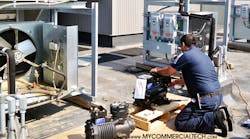A wise sales manager once said, “closing the sale is a logical conclusion to a good presentation.” This keeps with my philosophy of saying the most with the fewest words. Far too many “sales trainers” would have you believe that selling is a two part endeavor: 1) deliver the presentation and 2) whip the prospect into submission (close the sale). Veteran salespeople understand that the effective close is the one that isn’t detected, it’s almost
subliminal.
My first closing attempt is delivered at the very beginning of my final presentation. It sounds like this:
“Thank you for taking the time out of a busy meeting to share ideas pertaining to your HVAC systems. I encourage each of you to stop and ask questions as we go since, in about 20 minutes, you will be asked to make a very important decision.
In the first two sentences I encouraged dialogue and made my first assumptive close. As implied, the assumptive close assumes that the prospect will arrive at a positive decision. I typically spread two to three throughout my presentation in addition to the one in my opening remarks.
Others could be: “I noticed that that there is an empty closet in the equipment room. Would it be OK to store extra filters there?” or “who is the person to sign each of our service reports?"
Trial Close
The trial close is another method of guiding the prospect(s) to the conclusion. This type of close allows the salesperson to determine if he/she is hitting the target throughout the sales presentation. It directs the prospect(s) to buy into the individual benefits as they are presented. As they take ownership of each benefit, it prepares the prospect(s) for the final decision. It also provides a means for the salesperson to make necessary adjustments throughout the presentation
The Choice Close
The “choice” close effectively moves decision makers toward the final close with yet another positive response. This is when a salesperson gives the prospect(s) two choices, both leading toward buying the product or service. A couple of examples would be: “would you rather be billed quarterly or monthly?” or “would you prefer that our technicians park in front or along the side of the building?” Either choice is a win.
The Ben Franklin Close
The Ben Franklin close has been around for decades and, in some situations, still works. Benjamin Franklin made many critical decisions. Before arriving at a final decision, he would draw a vertical line down the middle of his paper. On the left side he would list all of the reasons for a positive decision, and on the right, the reasons not to proceed. I help the prospect with positive reasons to move forward, usually benefits that they’ve agreed to following a trial close. When it’s time to list the reasons not to buy, they’re on their own. This will also smoke out an occasional hidden objection.
The most deflating words a salesperson has to deal with is “We want to think it over.” If this delaying tactic is not dealt with, the chance of ever closing the sale is very limited. There is always a cost associated with this procrastination. The costs can come from the amount of projected energy savings that would be lost. I always break the savings loss into smaller increments.
For example, if we projected $12,000 per years savings with the PM program, I would respond, “each month we delay is another $1,000 loss to your budget.” I also refocus their attention to the seemingly smaller problems that have been previously identified. An example would be, “we have established that there are several problems that presently exist. Failing contactors, units short cycling, and air restrictions are relatively not that costly to remedy if done immediately. If ignored, a major failure could occur at any time.” I also try to instill some feeling of urgency. I will tell the prospect(s) that we are approaching a very busy time of year. I will go on to tell them that I have reserved a window of time that would allow us to start this week. If we delay and wander into peak season, scheduling will be much more critical.
I have noted over the years that salespeople (including myself) tend to have an abundance of common sense since we rarely use any of it. Common sense and reasoning usually trumps all else when closing the sale. Accompanied with a little emotion, common sense can move a group toward a positive decision. It would sound like this, “up until tonight, through no fault of your own, the present program has failed you. Would you give us a year to prove how a comprehensive PM program can deliver comfort, reduce and/or eliminate costly breakdowns, and put energy dollars back into your budget?"
Most Importantly, Ask for the Order.
This sounds academic, but too many times I’ve watched a well-prepared salesperson deliver a good presentation only to drop the ball crossing the goal line.











